 Your new post is loading...
 Your new post is loading...
"Teachers are the arbitrators of knowledge and culture. Knowledge and culture are each dynamic, endlessly crashing and churning. This makes teaching significantly important and difficult work, and can leave teaching—as a craft—wide-eyed and nonplussed in response. Worse, those outside the bubble of education can understandably struggle to understand the problem. What are the teaching in those schools anyway? How is it any different from when I was in school?"
"One overriding challenge is now coming to the fore in public consciousness: We need to reinvent just about everything. Whether scientific advances, technology breakthroughs, new political and economic structures, environmental solutions, or an updated code of ethics for 21st century life, everything is in flux—and everything demands innovative, out of the box thinking."
"No device should ever be hailed as the silver bullet in "saving" education -- nor should it be completely shunned -- but when it comes to the possibility of bridging the digital divide between low-income and high-income students, devices may play a pivotal role. ccess to the Internet connects kids to all kinds of information — and for low-income students especially, that access has the power to change their social structure by allowing them to become empowered and engaged..."
"If kids can access information from sources other than school, and if school is no longer the only place where information lives, what, then happens to the role of this institution?"
"Free, unstructured playtime gives kids a chance to discover their interests and tap into their creativity. It’s a crucial element for building resilience in children, an attribute they’ll need in order to become happy, productive adults."
This post provides a look at "what might happen if educators experimented with some of the lessons YouTube's staggering success has taught us." Ten items are listed, with explanation and a section called "possibility for teachers." The list includes: interdependence, diversity, brevity, selective social interaction, non-traditional, humor, cultural hyperbole, passive consumption, active selection and assisted discovery.
The Smithsonian asks and answers questions about science, art, history and culture, exciting the learning in everyone, every day. The Smithsonian has recently launched a new website seriouslyamazing.com which “poses questions and answers to show people how it can be an exciting resource for discovery and learning.” They have created " seven quirky characthers to symbolize the questions the Smithsonian asks and answers every day: * The Wild represents the diversity of the animal kingdom
* The Mash-Up stands for the ways people share culture
* The Green reflects the wonder of the natural landscape
* The New is where technology and creativity collide
* The Masterpiece embodies artistic expression
* The Storyteller is about America, its people and the tales they tell
* The Discoverer explores our world and the universe Take some time to explore this site. You may discover many new resources available at the Smithonian!
This post is written by a student and begins: Can creativity be taught? Absolutely. The real question is: “How do we teach it?” In school, instead of crossing subjects and classes, we teach them in a very rigid manner. Very rarely do you witness math and science teachers or English and history teachers collaborating with each other. Nikhil Goyal, a senior at Syosset High School then provides a look from the student viewpoint about what is and is not working in schools. A great read!
What is "deeper learning"? The National Research Council of the National Academies of Science released a report, Transferable Knowledge and Skills Key to Success in Education and Work. This report "calls for efforts to incorporate 'Deeper Learning' into curriculum." This post explores the three domains of competence that are discussed in the report: cognitive, intrapersonal and interpersonal. Each is defined and the question is raised, can deeper learning be taught? The post provides a great overview and here is the link to the full report: http://www7.nationalacademies.org/bota/Deeper_Learning_Report_Homepage2.html.
When we speak of 21st century learning we often hear the words innovation and creativity...but what can we do as educators to help our students develop these skills. How can we make our schools bcome idea factories for our students? Below is a list of 8 ideas. For more information click through to the article. * Welcome authentic questions. * Encourage effective teamwork. * Be ready to go big. * Build empathy. * Uncover passion. * Amplify worthy ideas. * Know when to say no. * Encourage breakthroughs.
"Print or digital? Adults grapple with which is the best way to read -- not only for themselves, but especially when it comes to their kids. Whether or not parents prefer print books over interactive e-books for their kids, the question is, what’s actually better for them?"
According to a recent study by the Joan Ganz Cooney Center, "kids age 3 to 6 remembered more narrative details - "What happened in the story?" - from print books than from enhanced e-books with multimedia features." However, this was not true when asking kids about the plot. Additional information is found in this post.
"When it comes to using technology in school, the tension between what students and parents want and what schools allow is becoming more apparent — and more divisive. Students want more control over how they use technology in school, but many classrooms are still making it difficult. That’s according to the most recent Speak Up 2011 report, “Mapping a Personalized Learning Journey,” which reflects the views of more than 416,000 K-12 students, parents, and educators nationwide surveyed on how technology can enhance the learning environment..."
"Do you think you’re creative?” Ask this question of a group of second-graders, and about 95 percent of them will answer “Yes.” Three years later, when the kids are in fifth grade, that proportion will drop to 50 percent—and by the time they’re seniors in high school, it’s down to 5 percent.
|
Although the students had been told at the outset that they should “study something important, including homework, an upcoming examination or project, or reading a book for a course,” it wasn’t long before their attention drifted: Students’ “on-task behavior” started declining around the two-minute mark as they began responding to arriving texts or checking their Facebook feeds. By the time the 15 minutes were up, they had spent only about 65 percent of the observation period actually doing their schoolwork.
"With one billion monthly users (and growing), YouTube's popularity is a pretty clear indication that video is a powerful medium. And kids' unrelenting fascination with videos is motivating many educators to find ways to leverage them for all kinds of purposes."
"Along with the big release last week of Amplify's tablet, produced by the education arm of media conglomerate News Corp, came details of the product that will vie for a spot in the growing education tablet market."
"Design thinking can seem a bit abstract to teachers. It’s not part of traditional teacher training programs and has only recently entered the teachers’ vernacular. Design thinking is an approach to learning that includes considering real-world problems, research, analysis, conceiving original ideas, lots of experimentation, and sometimes building things by hand. But few schools have the time or wherewithal to integrate these processes into the school day."
A look at why you might want to connect your students with students in other parts of the world (by two educators whom do this) as well as three resources to help you start on global collaboration. Five reasons with explanations are provided for the why, such as: * Working with students from different culture motivates students * It's easy to incorporate core curriculum lessons into global collaborations * It encourages problem solving For more information click through to the post.
The Space is a digital arts service from Arts Council England and the BBC, bringing great theatre, concerts, opera, dance, film and more to every screen. An amazing resource with dance, film, literature and spoken word, music, performance art, theater, and visual and media arts. The Space "...has been designed to give arts and culture organisations the opportunity to experiment and engage with new and existing audiences in a completely innovative digital environment. It is a pilot which was initially available from the 1st May 2012 to the 31st October 2012 and has now been extended until the 31st March 2013."
When we hear of flipping the classroom we think of videos at home and students doing "homework" at school, but what if we looked at whom tends to ask questions in the classroom? Is it the students or the teacher?
This article poses this question, "what if the students asked the questions?" The post states "It’s a bit like the Socractic method flipped on its head. Socrates wandered around Athens asking questions to get at a deeper truth. Since then philosophy and law teachers have used questions as a way to get students to think more deeply, rather than giving them the information directly." So how do you change your classroom so the students are the ones asking the questions? They suggest four rules and with two of them provide a number of examples. Rule 1 is:
* Ask As Many Questions as You Can (Gives License to Ask). They then discuss four stumbling blocks with suggestions on how to deal with them. To read the rest of the post click through!
When it comes to high achievement, grit may be as essential as intelligence. A look at a research study on grit, defined as "sticking with things over the very long term until you master them." Her "esearch suggests that when it comes to high achievement, grit may be as essential as intelligence. That’s a significant finding because for a long time, intelligence was considered the key to success." This post provides links to a variety of articles and a look at some recent reseach. It also suggest that "grit is something that people can probably learn."
A look at some "big-picture ideas" that may help you think about ways to bring new tools and innovations into your classroom. Each idea (listed below) provides a link to more information. * Infuse passion into learning * Try something new * Consider the flipped classroom model * Tap into students' ideas * Consider the future school day
We are ten years into No Child Left Behind and over the last year or so "Rampant and widespread cheating on high-stakes standardized tests has been uncovered in districts nationwide." What does this mean? "How did cheating become normal in America's schools?"
When the pressure is off grades and performance, kids focus on learning for the sake of learning, not to show off what they know, writes Annie Murphy Paul in this interesting post about a study examining the lasting effects of summer camp.
"The idea of mobile learning touches on just about every subject that any technology addresses: social media, digital citizenship, content-knowledge versus skill-building, Internet filtering and safety laws, teaching techniques, bring-your-own-device policies, school budgets. At its core, the issues associated with mobile learning get to the very fundamentals of what happens in class everyday. At their best, cell phones and mobile devices seamlessly facilitate what students and teachers already do in thriving, inspiring classrooms. Students communicate and collaborate with each other and the teacher. They apply facts and information they’ve found to formulate or back up their ideas. They create projects to deepen their understanding, association with, and presentation of ideas." Yet there may be issues also. This post explores mobile learning with a detailed example of a classroom where mobile phones are effectively integrated as well as a classroom where the integration did not go as well. A number of resources are also provided.
|



 Your new post is loading...
Your new post is loading...
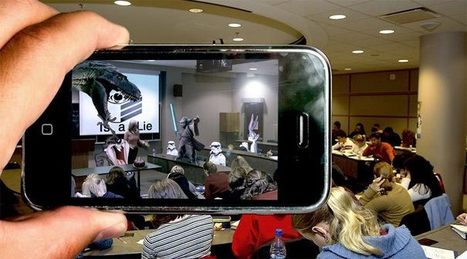









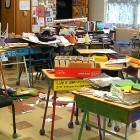
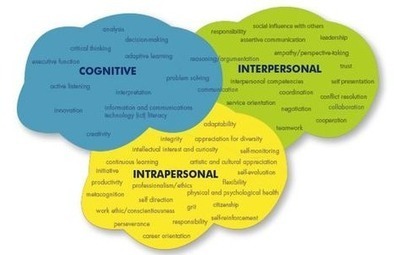
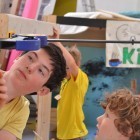

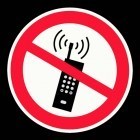

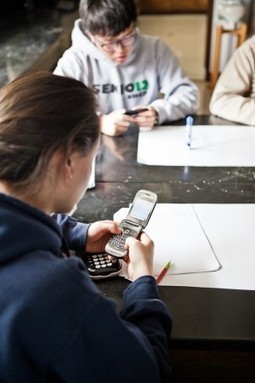
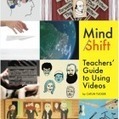













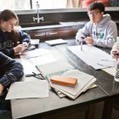





7 Ways Teaching Has Changed